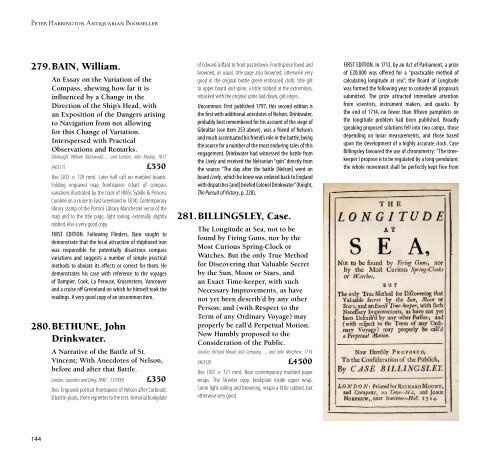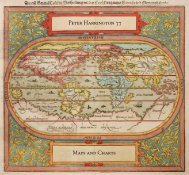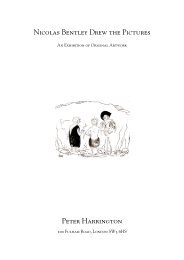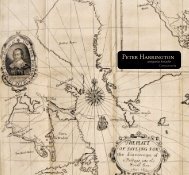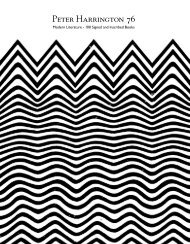antiquarian bookseller - Peter Harrington
antiquarian bookseller - Peter Harrington
antiquarian bookseller - Peter Harrington
Create successful ePaper yourself
Turn your PDF publications into a flip-book with our unique Google optimized e-Paper software.
<strong>Peter</strong> <strong>Harrington</strong> Antiquarian Bookseller<br />
279.BAIN, William.<br />
An Essay on the Variation of the<br />
Compass, shewing how far it is<br />
influenced by a Change in the<br />
Direction of the Ship’s Head, with<br />
an Exposition of the Dangers arising<br />
to Navigation from not allowing<br />
for this Change of Variation.<br />
Interspersed with Practical<br />
Observations and Remarks.<br />
Edinburgh, William Blackwood… and London, John Murray, 1817<br />
[40317] £550<br />
8vo (203 × 129 mm). Later half calf on marbled boards.<br />
Folding engraved map frontispiece (chart of compass<br />
variations illustrated by the track of HMSs Sybille & Princess<br />
Caroline on a cruise to East Greenland in 1814). Contemporary<br />
library stamp of the Portico Library Manchester verso of the<br />
map and to the title page, light toning, externally slightly<br />
rubbed, else a very good copy.<br />
FIRST EDITION. Following Flinders, Bain sought to<br />
demonstrate that the local attraction of shipboard iron<br />
was responsible for potentially disastrous compass<br />
variations and suggests a number of simple practical<br />
methods to obviate its effects or correct for them. He<br />
demonstrates his case with reference to the voyages<br />
of Dampier, Cook, La Perouse, Krusenstern, Vancouver<br />
and a cruise off Greenland on which he himself took the<br />
readings. A very good copy of an uncommon item.<br />
280.BETHUNE, John<br />
Drinkwater.<br />
A Narrative of the Battle of St.<br />
Vincent; With Anecdotes of Nelson,<br />
before and after that Battle.<br />
London, Saunders and Otley, 1840 [37906] £350<br />
8vo. Engraved portrait frontispiece of Nelson after Corbould,<br />
8 battle-plans, three vignettes to the text. Armorial bookplate<br />
of Edward Giffard to front pastedown. Frontispiece foxed and<br />
browned, as usual, title page also browned, otherwise very<br />
good in the original bottle green embossed cloth, title gilt<br />
to upper board and spine, a little rubbed at the extremities,<br />
rebacked with the original spine laid down, gilt edges.<br />
Uncommon. First published 1797, this second edition is<br />
the first with additional anecdotes of Nelson. Drinkwater,<br />
probably best remembered for his account of the siege of<br />
Gibraltar (see item 253 above), was a friend of Nelson’s<br />
and much accentuated his friend’s role in the battle, being<br />
the source for a number of the most enduring tales of this<br />
engagement. Drinkwater had witnessed the battle from<br />
the Lively and received the Nelsonian “spin” directly from<br />
the source: “The day after the battle [Nelson] went on<br />
board Lively, which he knew was ordered back to England<br />
with dispatches [and] briefed Colonel Drinkwater” (Knight,<br />
The Pursuit of Victory, p. 228).<br />
281.BILLINGSLEY, Case.<br />
The Longitude at Sea, not to be<br />
found by Firing Guns, nor by the<br />
Most Curious Spring-Clock or<br />
Watches. But the only True Method<br />
for Discovering that Valuable Secret<br />
by the Sun, Moon or Stars, and<br />
an Exact Time-keeper, with such<br />
Necessary Improvements, as have<br />
not yet been describ’d by any other<br />
Person; and (with Respect to the<br />
Term of any Ordinary Voyage) may<br />
properly be call’d Perpetual Motion.<br />
Now Humbly proposed to the<br />
Consideration of the Public.<br />
London, Richard Mount and Company,… and John Morphew, 1714<br />
[40318] £4500<br />
8vo (187 × 121 mm). Near contemporary marbled paper<br />
wraps. The Streeter copy, bookplate inside upper wrap.<br />
Some light soiling and browning, wraps a little rubbed, but<br />
otherwise very good.<br />
FIRST EDITION. In 1713, by an Act of Parliament, a prize<br />
of £20,000 was offered for a “practicable method of<br />
calculating longitude at sea”; the Board of Longitude<br />
was formed the following year to consider all proposals<br />
submitted. The prize attracted immediate attention<br />
from scientists, instrument makers, and quacks. By<br />
the end of 1714, no fewer than fifteen pamphlets on<br />
the longitude problem had been published. Broadly<br />
speaking proposed solutions fell into two camps, those<br />
depending on lunar measurements, and those based<br />
upon the development of a highly accurate clock. Case<br />
Billingsley favoured the use of chronometry: “The timekeeper<br />
I propose is to be regulated by a long-pendulum;<br />
the whole movement shall be perfectly kept free from<br />
damps, and secured from all extraneous air: it may go<br />
above a year without any persons touching it, it shall<br />
move in a proper, tho’ not in a common body, and in such<br />
a part of the ship, and such a position as to be always<br />
perpendicular, tho’ the ship tosses or rowls never so<br />
much; the motion of the sea shall not alter it, so as to<br />
occasion any considerable error; and the pendulum-rod<br />
shall be secured from lengthening by heat, or shortning<br />
by cold. The whole charge of which, for a great ship, and<br />
all that must secure it from injuries by the motion of the<br />
ship, wet, heat, air, &c. will not be great; and (barring<br />
accidents) will last above thirty years.” The practical<br />
Catalogue 57: Travel Section 7: Mapping, Navigation and Naval History<br />
difficulties of making such a clock proved great; in the<br />
end the prize was won by the horologist John Harrison,<br />
but in the final payment of the reward was not paid until<br />
1773. All of the longitude pamphlets published in 1714<br />
are rare, and seldom appear on the market. Four copies<br />
on COPAC, OCLC adds just three copies. Case Billingsley<br />
was a London broker and “projector”, who had previously<br />
served as a purser with the Royal Navy. A number of his<br />
schemes during the period of the South Sea Bubble<br />
ran into difficulties, but he seems to have escaped<br />
imprisonment by fleeing abroad.<br />
Adams & Waters, English Maritime Books printed before 1801,<br />
164.<br />
282.BION, Nicolas.<br />
L’Usage des Globes Céleste et<br />
Terrestre, et des Spheres Suivant<br />
les Différens Systêmes du<br />
Monde. Précédé d’un Traité de<br />
Cosmographie … Sixiéme Edition,<br />
revûe, & corrigée.<br />
Paris: Jacques Guerin et Nyon fils, 1751 [9020] £1200<br />
8vo. Contemporary mottled calf, red morocco label, gilt floral<br />
decoration and raised bands on spine, gilt lower edges and<br />
Bion’s first publication<br />
marbled endpapers. With 49 engraved plates including one<br />
folding celestial and one folding lunar map, folding maps<br />
of the world, the four continents, Northern Europe with<br />
Iceland, Germany, France, Italy, Spain, and the Low Countries,<br />
astronomical illustrations, etc. Edges slightly bumped. Some<br />
light foxing to endpapers and the first few leaves, otherwise<br />
crisp clean. A near fine copy.<br />
Last and revised edition of Bion’s (1652–1733) first<br />
publication, edited by his son. This treatise on globes,<br />
spheres, and cosmography was first published in 1699<br />
and turned out to become the author’s most popular<br />
publication, of which a German translation appeared in<br />
1738. “True to the spirit of the age Bion gave much thought<br />
to the idea of reform in the matter of globe construction,<br />
especially to the surface of the sphere” (E. L. Stevenson).<br />
Graesse I, 429; Poggendorff I, 194f; Houzeau/Lancaster 9735; Stevenson,<br />
Terrestrial and Celestial Globes (1921) II, 153; Quérard, La France litteraire I,<br />
340 (erroneously dated 1561).<br />
144 145


